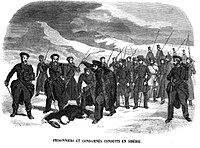
Photo from wikipedia
ABSTRACT The European Union put in place instruments for the deportation of foreigners that gained much importance. This article describes the multiplicity and diversity of these instruments. To analyse them… Click to show full abstract
ABSTRACT The European Union put in place instruments for the deportation of foreigners that gained much importance. This article describes the multiplicity and diversity of these instruments. To analyse them more clearly, it distinguishes three types: legal, organisational and technological. The article equally points to the increasing relevance of technological tools, especially the use of biometrics. It also looks at how a founding member of the EU, France, and an associated country, Switzerland, utilise these European instruments to deport foreigners by focusing on the Dublin III Regulation as well as the Eurodac database, jointly referred to as the Dublin System. Grounding on a comparative study combining documentary analysis and semi-structured interviews and participant observation, this article describes the similarities and differences in the use of the Dublin System in these two countries. Moreover, it also reveals these countries’ specificities with regard to the roles played by local and national administrative bodies, and associative actors. The paper ends by concluding that to fully understand the deportation process in the European context as well as in certain countries, a multifaceted approach is required to make sense of the various interactions taking place between local, national and supranational frameworks, actors and practices.
Journal Title: Journal of Ethnic and Migration Studies
Year Published: 2020
Link to full text (if available)
Share on Social Media: Sign Up to like & get
recommendations!